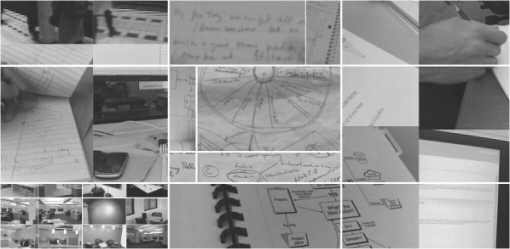The Facts…
Plan
How might analytical thinking and design thinking integrate to form a transdisciplinary approach to problem solving? ; It’s a large question and to tackle it I started by trying to get a better understanding of what is analytical thinking. To what degree can analytical thinking be separated from creative thinking? Where and how might the two integrate? I decided to research how the visual output and language of persons from more analytical backgrounds could be informative of this community. To what extent can they can be ‘visual thinkers’ and thus be naturally incorporating a thinking style that is more associated to creative’s?
Action
I decided to use participatory photography as a medium and selected a sample of people from finance and marketing backgrounds. I proceeded to ask them to photograph any of their visual representations during their work process (their notes, whiteboards, presentations and any other similar outlets). I stressed on quality over quantity and expressed to them that they was no right or wrong.
Observation
What went wrong? Most of the pictures from 2 out of the 3 informants pictures were not of their visual process. They consisted of objects and spaces. On questioning them, I realized that they understood the brief as a means to represent their ‘work process’. Only on re-briefing did they take a few photographs of their visual process. However I did note that the third informant was able to share with me his visualization process in the first round itself. He photographically documented how he uses diagramming and visualization on large sheets of paper for creating business plans which he eventually documents on more traditional software’s like excel sheets, word documents etc.
The Negative…
Reflection
Why it went wrong? On reflection I find the main mistake I have made is by choosing an inappropriate tactic for the intended research subject. I wrongly assumed that an essentially non-visual community (although I still do not doubt there capabilities as visual thinkers) would be able to best represent themselves through a visual medium like participatory photography. Hence I realized that one must take care while applying a participatory approach. It might not be the best way for a community to communicate, express or represent themselves if the medium is not appropriate for them.
Another important fact to consider during participatory photography (or any other tactic as well) is the execution of the tactic. There was a clear miscommunication and misunderstanding between me and the first two informants about the intent of the activity they were to perform.
Here my background and biasness might have been a problem. Being in constant interaction with designers, I assumed that the informant would understand the intent of such a creative brief and exercise it the same way a person from a more creative background might.
The Positive…
This critical analysis has helped me to take forward my research with a clearer understanding of applying research tactics as well as my research subject itself. Reflections in design research being mostly qualitative and subjective, It is possible that a wrong decision can lead to the researcher unintentionally going ahead with the next action cycle of their research with skewed data and insights. The solution to this is stepping back from the research bubble once in a while. Self-reflection as well as sharing your research with selective people can be very helpful and insightful.
The Potential…
By understanding that a non-visual community might not be able to represent themselves most effectively through visual means, this has reinforced to me the potential of the creative community to represent themselves through their visualizations. One might get insights into how designers think from how they are visualize their thoughts and processes. Hence by studying the approach taken for the visual language of process diagrams (abstract vs. systematic, linear vs. cyclic, inductive vs. deductive, 2d vs. 3d etc) one might derive insights and indicators about that process and the community following that process. I have come to a new research question; how might the attributes and variations of visual representations of a process be informative and indicative about the community depicting it?
